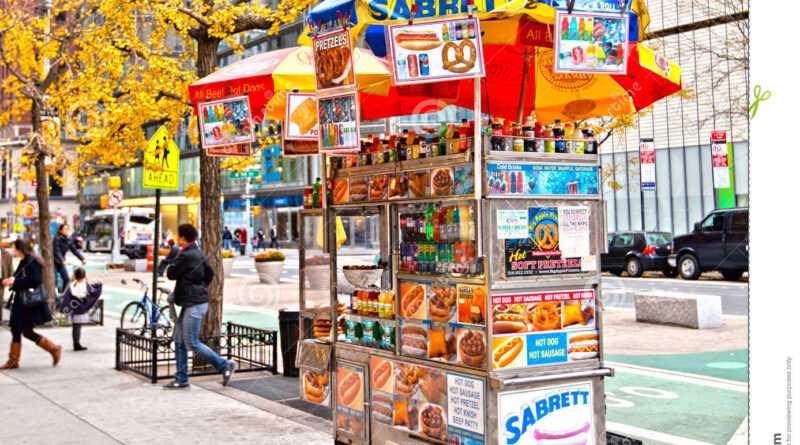New York City Food Scene
New York City is a culinary mecca, known for its diverse and vibrant food scene that reflects its multicultural population. From the street food carts of Midtown Manhattan to the high-end restaurants of the Upper East Side, NYC offers a dining experience like no other. The city’s food culture is a blend of tradition and innovation, with influences from around the world coming together to create a unique and dynamic gastronomic landscape. Whether you’re a food connoisseur or a casual eater, New York City’s food scene promises something to delight every palate.
Historical Evolution of NYC’s Food Scene
The evolution of New York City’s food scene is deeply intertwined with its history of immigration. In the late 19th and early 20th centuries, waves of immigrants from Italy, Ireland, Germany, Eastern Europe, and later, Asia and Latin America, brought their culinary traditions with them. These diverse cultural influences laid the foundation for NYC’s eclectic food offerings. The Lower East Side, for example, became synonymous with Jewish delicacies like bagels and lox, while Little Italy and Chinatown emerged as culinary epicenters for Italian and Chinese cuisines, respectively. Over time, these neighborhoods have continued to evolve, with new generations of immigrants introducing fresh flavors and ingredients to the city’s culinary repertoire.
Iconic New York Foods
New York City is home to some of the most iconic foods in the United States. The New York bagel, with its chewy texture and variety of toppings, is a breakfast staple for many New Yorkers. Pizza, particularly the thin-crust, foldable New York slice, is a city institution, with pizzerias like Lombardi’s and Di Fara setting the standard for generations. The hot dog, often enjoyed from a street vendor or at a ballgame, is another quintessential NYC food, famously sold at Nathan’s in Coney Island. And, of course, no discussion of New York foods would be complete without mentioning the classic New York cheesecake, rich and creamy with a graham cracker crust, a dessert beloved by locals and tourists alike.
Neighborhood Food Cultures
Each of New York City’s five boroughs has its own distinct culinary identity, shaped by its residents and history.
- Manhattan is the epicenter of fine dining, with neighborhoods like the West Village and the Upper East Side offering everything from Michelin-starred restaurants to trendy bistros.
- Brooklyn has become synonymous with artisanal food and craft cuisine, particularly in areas like Williamsburg and DUMBO, where you can find innovative eateries, hip cafes, and food markets.
- Queens is often hailed as the most diverse borough, with neighborhoods like Jackson Heights and Flushing offering a melting pot of flavors from around the world, including Indian, Chinese, and Latin American cuisines.
- The Bronx is known for its rich Italian heritage, particularly in the Belmont area, home to the famous Arthur Avenue, as well as its burgeoning scene of Caribbean and African restaurants.
- Staten Island offers a blend of Italian-American classics and an emerging scene of Sri Lankan eateries, making it a borough full of hidden culinary gems.
High-End Dining in NYC
New York City is a global leader in high-end dining, boasting more Michelin-starred restaurants than almost any other city in the world. Restaurants like Eleven Madison Park, Per Se, and Le Bernardin have become synonymous with culinary excellence, attracting food enthusiasts from across the globe. The city’s fine dining scene is characterized by its diversity, with establishments offering everything from traditional French cuisine to cutting-edge molecular gastronomy. Many of these restaurants are helmed by celebrity chefs, whose innovative approaches to cooking continue to push the boundaries of what is possible in the culinary world.
Street Food Culture
While New York City is known for its luxury dining options, it is equally celebrated for its vibrant street food culture. Food trucks and street carts are a ubiquitous part of the city’s landscape, offering a quick and affordable way to sample a wide variety of cuisines. From the Halal Guys’ famous chicken and rice to the city’s countless taco trucks, street food is a beloved part of the New York experience. The city’s street vendors reflect its diversity, with options ranging from Middle Eastern falafel to Korean BBQ, all of which can be enjoyed on the go. This street food scene is not just about convenience; it represents the entrepreneurial spirit of the city’s residents and their ability to create something special out of a small space.
Ethnic Cuisine Diversity
New York City’s food scene is a true melting pot, with ethnic cuisines from every corner of the globe.
- Italian cuisine has deep roots in NYC, with Little Italy offering classic dishes like pasta, cannoli, and espresso, while newer establishments bring modern twists to traditional recipes.
- Chinese cuisine thrives in Chinatown, but also in Flushing, Queens, where you can find some of the most authentic Chinese food outside of China, from dim sum to hand-pulled noodles.
- Mexican food has a strong presence, with taquerias scattered throughout the city offering everything from tacos al pastor to tamales.
- Jewish cuisine is well-represented, particularly in the Lower East Side, where you can find traditional deli staples like pastrami on rye, matzo ball soup, and knishes.
- Indian food shines in neighborhoods like Jackson Heights, Queens, where the streets are lined with restaurants serving up spicy curries, naan, and samosas.
- The city’s Middle Eastern and Mediterranean communities also contribute significantly to the food scene, with restaurants offering everything from shawarma to baklava.
Food Markets and Festivals
New York City’s food markets and festivals are a testament to its vibrant culinary culture. Smorgasburg, one of the largest open-air food markets in America, is a must-visit for food lovers, offering an array of artisanal food vendors in a picturesque Brooklyn setting. Union Square Greenmarket is another iconic spot, where local farmers sell fresh produce, meats, cheeses, and baked goods. NYC also hosts numerous food festivals throughout the year, such as the New York City Wine & Food Festival, which attracts celebrity chefs and food enthusiasts from around the world. These events provide an opportunity to sample a wide variety of dishes and learn about the latest trends in the culinary world.
Vegetarian and Vegan Dining
The rise of plant-based eating has not gone unnoticed in New York City. The city has seen a significant increase in vegetarian and vegan restaurants, catering to the growing demand for healthier and more sustainable dining options. Establishments like Superiority Burger and Avant Garden offer creative and flavorful plant-based dishes that even the most devoted carnivores can enjoy. Additionally, many traditional restaurants have expanded their menus to include vegetarian and vegan options, reflecting the city’s commitment to culinary inclusivity. Whether you’re looking for a gourmet vegan meal or a simple, hearty salad, NYC has plenty of options to satisfy your cravings.
Farm-to-Table Movement
Sustainability and local sourcing have become central themes in New York City’s food scene, with the farm-to-table movement gaining significant traction. Restaurants like Blue Hill at Stone Barns and ABC Kitchen are pioneers in this movement, focusing on seasonal ingredients sourced directly from local farms. This approach not only supports the local economy but also ensures that diners enjoy the freshest and most flavorful ingredients available. The farm-to-table movement has also influenced the way New Yorkers shop for food, with an increasing number of people choosing to buy their produce, meats, and dairy products from farmers’ markets and local suppliers.
NYC’s Coffee Culture
New York City’s coffee culture is as diverse as its food scene, with a wide range of options catering to every type of coffee drinker. Independent coffee shops are scattered throughout the city, each offering its unique take on the classic cup of joe. The third-wave coffee movement has made a significant impact, emphasizing quality, sustainability, and the art of brewing. Cafes like Stumptown Coffee Roasters and Blue Bottle Coffee have become popular spots for coffee enthusiasts, while smaller, neighborhood cafes continue to thrive. NYC’s coffee culture also extends to its vibrant social scene, with coffee shops often serving as gathering places for creatives, freelancers, and entrepreneurs.
Bakeries and Dessert Spots
New York City is home to some of the best bakeries and dessert spots in the world, making it a paradise for those with a sweet tooth. Dominique Ansel Bakery, famous for creating the Cronut, has become a must-visit destination for pastry lovers. Traditional bakeries like Breads Bakery and Levain Bakery are renowned for their challah, babka, and oversized cookies. Dessert aficionados can also explore a range of artisanal ice cream shops, such as Morgenstern’s Finest Ice Cream, offering unique and innovative flavors. Whether you’re in the mood for a classic slice of cake or a trendy new dessert, NYC has something to satisfy every craving.
The Rise of Food Halls
Food halls have become an increasingly popular dining concept in New York City, offering a variety of culinary experiences under one roof. Chelsea Market is one of the most famous examples, housing a diverse selection of food vendors, from seafood to tacos to gourmet donuts. Time Out Market New York in Dumbo, Brooklyn, features some of the city’s best chefs and restaurateurs, providing a curated dining experience with stunning views of the Manhattan skyline. These food halls cater to both locals and tourists, offering a convenient way to sample a wide array of cuisines in a single location.
Fusion and Experimental Cuisine
New York City is a playground for chefs who love to experiment and push the boundaries of traditional cuisine. Fusion restaurants, where chefs combine elements from different culinary traditions, have flourished in NYC. Restaurants like Momofuku by David Chang and Korean-fusion restaurants blend flavors and techniques from different cultures to create something entirely new. This spirit of innovation is also evident in the city’s thriving pop-up dining scene, where temporary restaurants and supper clubs offer chefs the freedom to test new ideas and concepts. NYC’s experimental food scene is a testament to the city’s role as a global culinary leader, where creativity knows no bounds.
Late-Night Dining
New York City is truly the city that never sleeps, and this is reflected in its late-night dining scene. Whether you’re craving a slice of pizza at 3 AM or a gourmet meal after a night out, NYC has plenty of options. The city’s 24-hour diners are legendary, offering everything from pancakes to burgers around the clock. Katz’s Delicatessen, one of the most famous late-night spots, has been serving its iconic pastrami sandwiches since 1888. For those looking for something a bit more upscale, there are late-night eateries in neighborhoods like the East Village and Williamsburg that offer creative small plates and cocktails well into the early morning hours.
Food Tourism in NYC
New York City is a prime destination for food tourism, attracting visitors from around the world who come to experience its culinary delights. Food tours are a popular way to explore the city’s diverse neighborhoods, with guides offering insights into the history and culture behind each dish. From walking tours of Chinatown’s dim sum spots to tastings of artisanal chocolates in Brooklyn, there’s a food tour for every palate. NYC is also home to numerous cooking schools and workshops, where visitors can learn to make everything from pizza to pastries. For many tourists, exploring New York’s food scene is just as important as visiting its iconic landmarks.
The Future of NYC’s Food Scene
The food scene in New York City is constantly evolving, driven by changing tastes, economic factors, and social trends. The COVID-19 pandemic had a significant impact on the city’s restaurants, with many facing closures and adapting to new business models. However, the resilience of New York’s food industry has shone through, with new restaurants and concepts emerging even in the face of adversity. Sustainability, local sourcing, and plant-based dining are likely to continue to shape the future of NYC’s food scene, as diners become more conscious of the environmental impact of their choices. Additionally, the rise of technology, such as online ordering and delivery apps, will continue to influence how New Yorkers dine.
Conclusion
New York City’s food scene is a reflection of its status as a global capital of culture and innovation. From its iconic street foods to its high-end dining establishments, the city offers a culinary experience that is unparalleled in its diversity and creativity. The constant influx of new ideas, ingredients, and cultures ensures that New York’s food scene is always evolving, offering something new for both locals and visitors to discover. As the city continues to grow and change, its food scene will undoubtedly remain one of the most dynamic and exciting in the world.
Discover more from City Towner
Subscribe to get the latest posts sent to your email.




